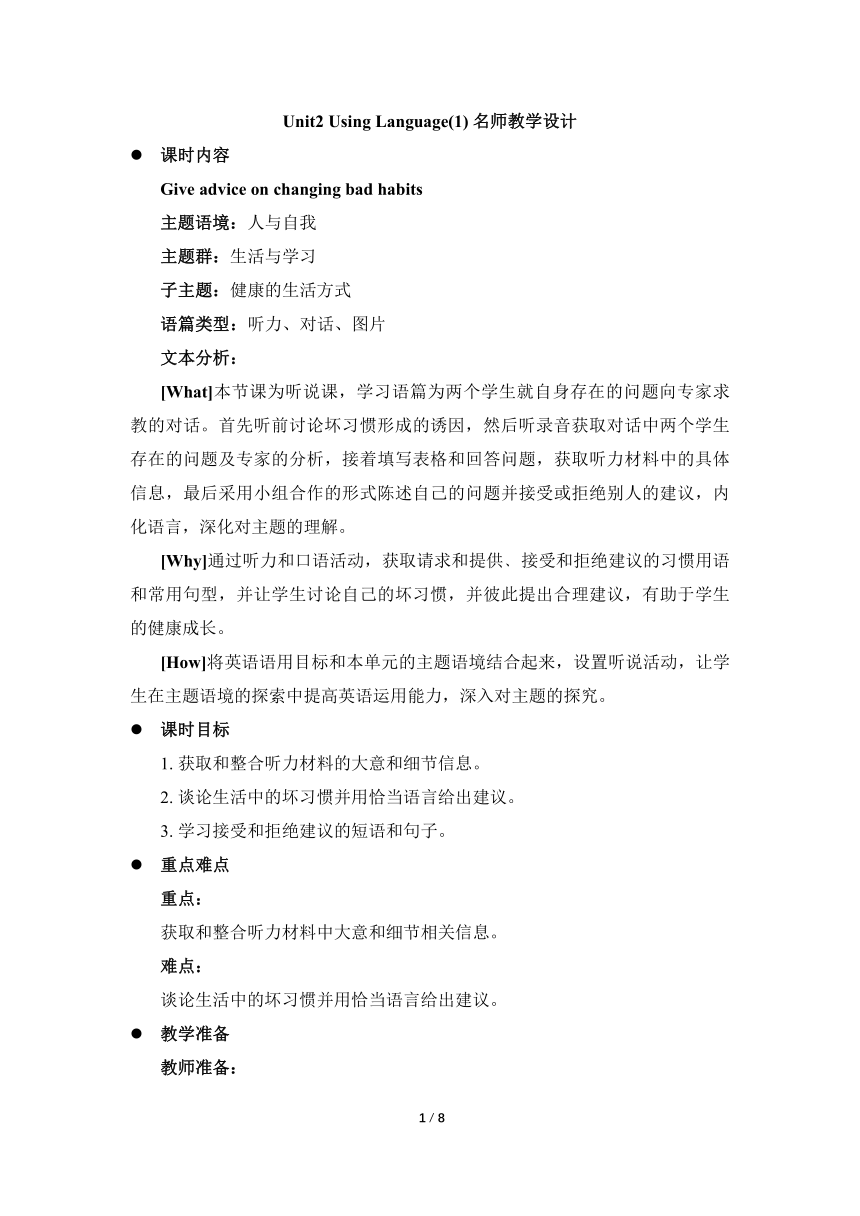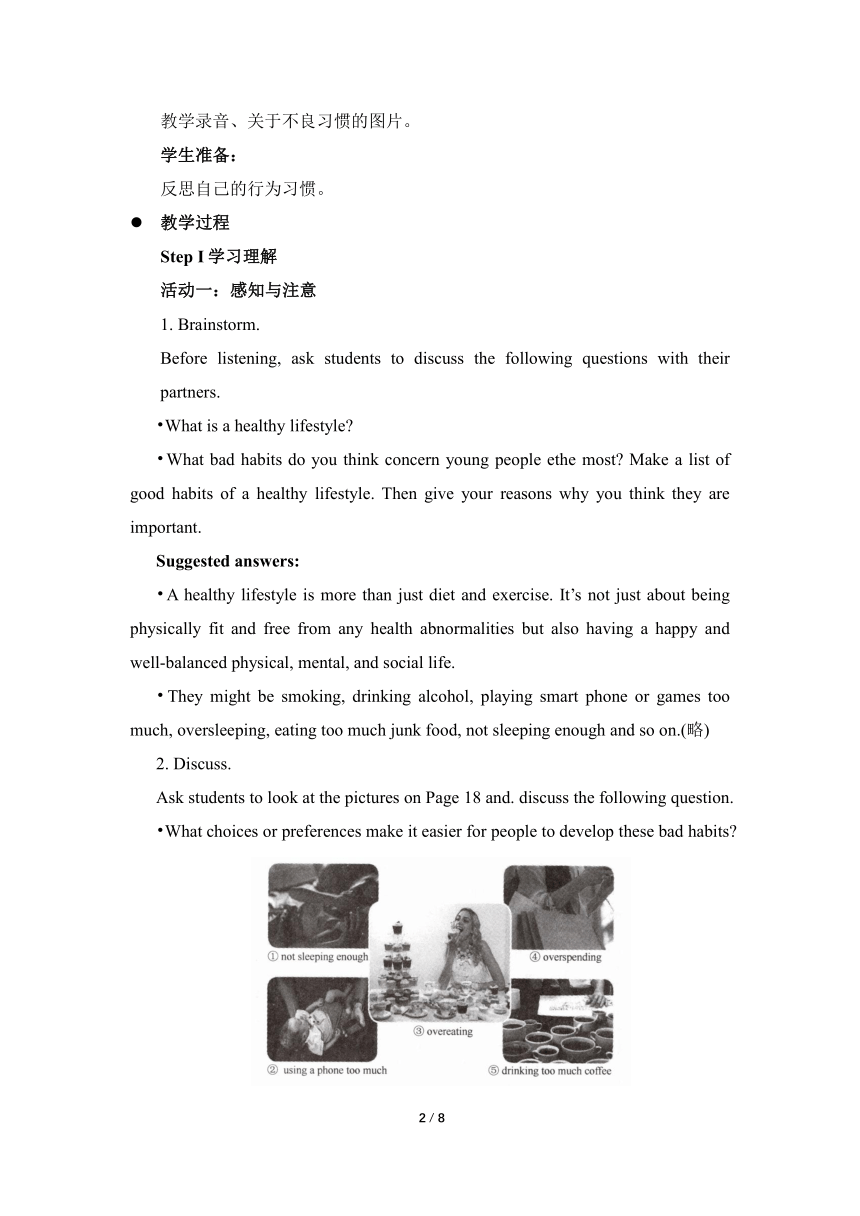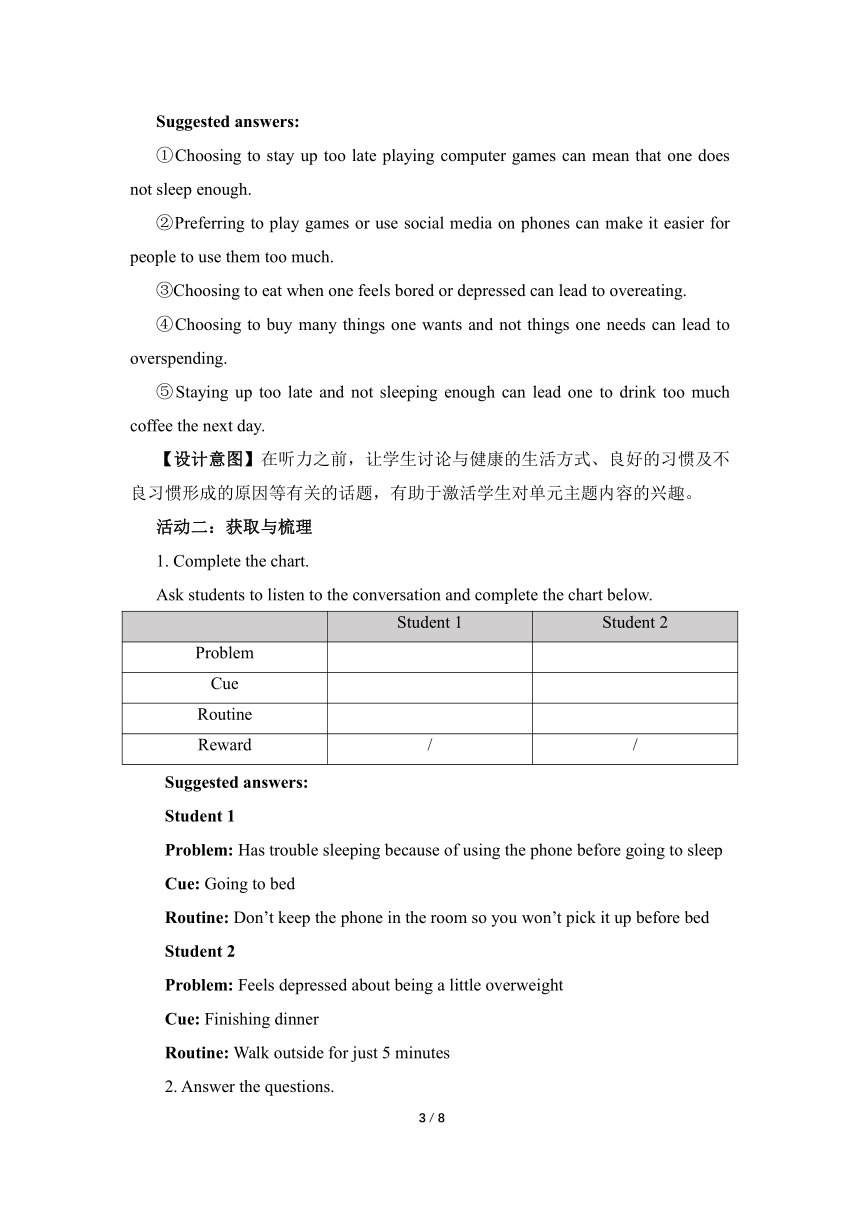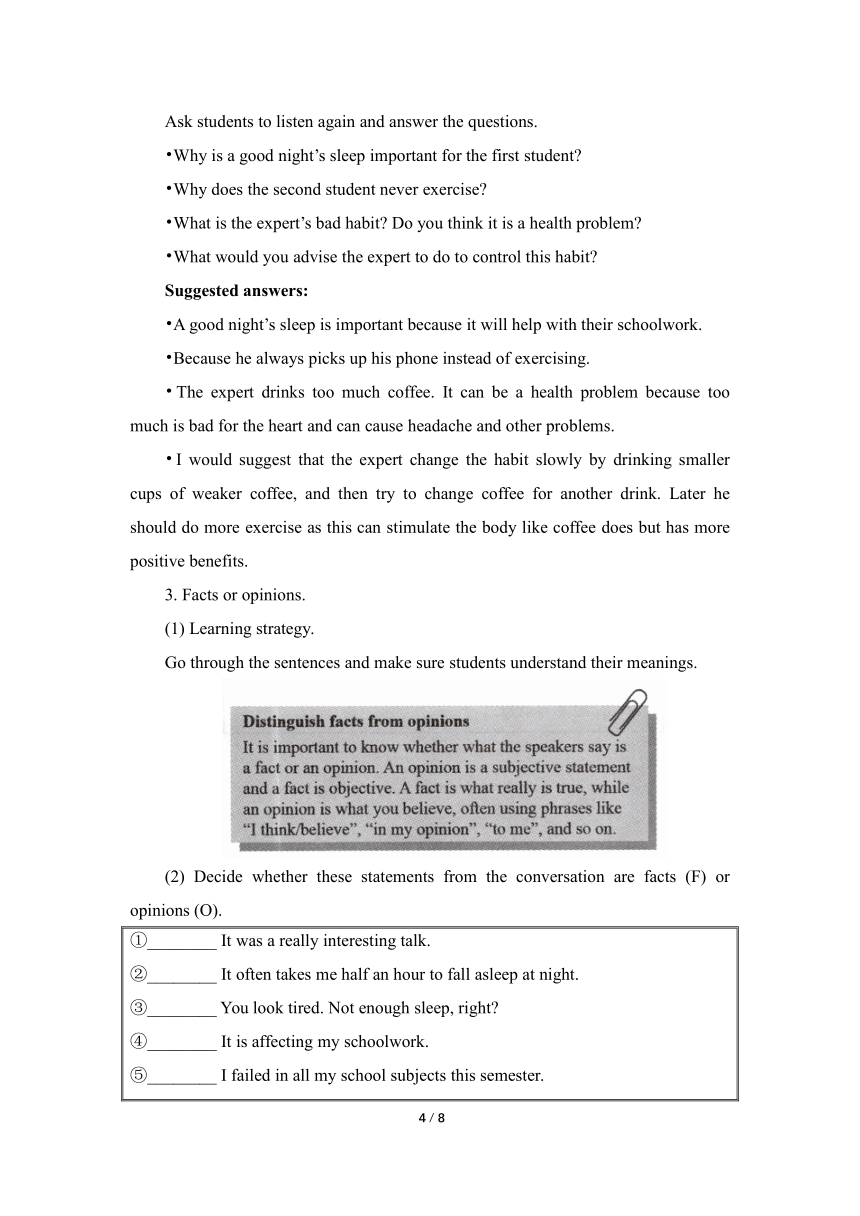人教版(2019)选择性必修第三册 Unit2 Healthy Lifestyle Using Language(1) 名师教学设计
文档属性
| 名称 | 人教版(2019)选择性必修第三册 Unit2 Healthy Lifestyle Using Language(1) 名师教学设计 |  | |
| 格式 | docx | ||
| 文件大小 | 2.4MB | ||
| 资源类型 | 教案 | ||
| 版本资源 | 人教版(2019) | ||
| 科目 | 英语 | ||
| 更新时间 | 2023-03-13 00:00:22 | ||
图片预览




文档简介
Unit2 Using Language(1) 名师教学设计
课时内容
Give advice on changing bad habits
主题语境:人与自我
主题群:生活与学习
子主题:健康的生活方式
语篇类型:听力、对话、图片
文本分析:
[What]本节课为听说课,学习语篇为两个学生就自身存在的问题向专家求教的对话。首先听前讨论坏习惯形成的诱因,然后听录音获取对话中两个学生存在的问题及专家的分析,接着填写表格和回答问题,获取听力材料中的具体信息,最后采用小组合作的形式陈述自己的问题并接受或拒绝别人的建议,内化语言,深化对主题的理解。
[Why]通过听力和口语活动,获取请求和提供﹑接受和拒绝建议的习惯用语和常用句型,并让学生讨论自己的坏习惯,并彼此提出合理建议,有助于学生的健康成长。
[How]将英语语用目标和本单元的主题语境结合起来,设置听说活动,让学生在主题语境的探索中提高英语运用能力,深入对主题的探究。
课时目标
1. 获取和整合听力材料的大意和细节信息。
2. 谈论生活中的坏习惯并用恰当语言给出建议。
3. 学习接受和拒绝建议的短语和句子。
重点难点
重点:
获取和整合听力材料中大意和细节相关信息。
难点:
谈论生活中的坏习惯并用恰当语言给出建议。
教学准备
教师准备:
教学录音、关于不良习惯的图片。
学生准备:
反思自己的行为习惯。
教学过程
Step I学习理解
活动一:感知与注意
1. Brainstorm.
Before listening, ask students to discuss the following questions with their partners.
What is a healthy lifestyle
What bad habits do you think concern young people ethe most Make a list of good habits of a healthy lifestyle. Then give your reasons why you think they are important.
Suggested answers:
A healthy lifestyle is more than just diet and exercise. It’s not just about being physically fit and free from any health abnormalities but also having a happy and well-balanced physical, mental, and social life.
They might be smoking, drinking alcohol, playing smart phone or games too much, oversleeping, eating too much junk food, not sleeping enough and so on.(略)
2. Discuss.
Ask students to look at the pictures on Page 18 and. discuss the following question.
What choices or preferences make it easier for people to develop these bad habits
Suggested answers:
①Choosing to stay up too late playing computer games can mean that one does not sleep enough.
②Preferring to play games or use social media on phones can make it easier for people to use them too much.
③Choosing to eat when one feels bored or depressed can lead to overeating.
④Choosing to buy many things one wants and not things one needs can lead to overspending.
⑤Staying up too late and not sleeping enough can lead one to drink too much coffee the next day.
【设计意图】在听力之前,让学生讨论与健康的生活方式、良好的习惯及不良习惯形成的原因等有关的话题,有助于激活学生对单元主题内容的兴趣。
活动二:获取与梳理
1. Complete the chart.
Ask students to listen to the conversation and complete the chart below.
Student 1 Student 2
Problem
Cue
Routine
Reward / /
Suggested answers:
Student 1
Problem: Has trouble sleeping because of using the phone before going to sleep
Cue: Going to bed
Routine: Don’t keep the phone in the room so you won’t pick it up before bed
Student 2
Problem: Feels depressed about being a little overweight
Cue: Finishing dinner
Routine: Walk outside for just 5 minutes
2. Answer the questions.
Ask students to listen again and answer the questions.
Why is a good night’s sleep important for the first student
Why does the second student never exercise
What is the expert’s bad habit Do you think it is a health problem
What would you advise the expert to do to control this habit
Suggested answers:
A good night’s sleep is important because it will help with their schoolwork.
Because he always picks up his phone instead of exercising.
The expert drinks too much coffee. It can be a health problem because too much is bad for the heart and can cause headache and other problems.
I would suggest that the expert change the habit slowly by drinking smaller cups of weaker coffee, and then try to change coffee for another drink. Later he should do more exercise as this can stimulate the body like coffee does but has more positive benefits.
3. Facts or opinions.
(1) Learning strategy.
Go through the sentences and make sure students understand their meanings.
(2) Decide whether these statements from the conversation are facts (F) or opinions (O).
①________ It was a really interesting talk. ②________ It often takes me half an hour to fall asleep at night. ③________ You look tired. Not enough sleep, right ④________ It is affecting my schoolwork. ⑤________ I failed in all my school subjects this semester. ⑥________ I usually pick up my phone. ⑦________ I think the phone is the problem. ⑧________ A five-minute walk is so easy that it is hard to say no!
Suggested answers:
①O ②F ③O ④F ⑤F ⑥F ⑦O ⑧O
【设计意图】通过完成表格、回答问题和判断活动,学生获取听力材料的相关细节信息,有助于单元主题意义的理解,也有利于口语活动的开展。
Step Ⅱ 应用实践
活动三:分析与判断
Ask students to work in pairs and discuss the opinions in last activity with a partner and see if they agree on them. Have students give some suggestions for the problems.
【设计意图】在听力之后,让学生讨论自己是否同意听力材料中的观点并尝试给出自己的建议,有助于对听力材料的深入理解,也有助于提高学生对听力深度理解的能力。
活动四:描述与阐释
1. Choose a bad habit.
Ask students to choose a bad habit from the following pictures and have a conversation with their partner about it. The expressions below may help them.
sleeping too much Internet addict
overeating staying up too late
game addict overspending
TV addict smoking
2. Learn language.
(1) Ask students to read the following structures.
Asking for and giving advice My problem is... I’m having problems with... I cannot stop. Please give me some advice about... I think/ believe you should... So, why don’t you... Well, have you thought about... In my opinion, …
Accepting and refusing advice Sure, I’l1 do that. That’s a good idea! That's just what I need! Lovely! Great! Terrific idea! Sorry, but I... I’d like/ love to..., but… That’s a good idea, but... Thank you for telling me, but… It’s a nice thought, but… I cannot...because…
(2) Ask students to make a conversation about asking for and giving advice.
Example
A: I think I'm watching too much TV.
B: Yeah. Me too.
C: In my opinion, you should spend your time on something more active instead. For example, try to get more exercise.
B: OK, sure, I’ll try that.
A: That’s a nice thought, but I don’t really enjoy exercising.
C: Hmm. How about reading more books instead
A: All right, maybe I can try that.
【设计意图】在口语对话之前,教师给学生提供一些图片以及请求和提供建议﹑接受和拒绝建议的句型,为口语活动提供了语境和语言结构,使得学生有话可说。在这个过程实现了所学语言的内化,提高了学生的语言表达能力,深化了对主题的认识。
Step Ⅲ 迁移创新
活动五:想象与创造
1. Ask students to think about at least three of their bad habits, and then exchange them with their partner.
2. Ask students to give advice on their partner’s bad habits.
【设计意图】通过反思自己的坏习惯,并和同伴相互交流,彼此给出建议,帮助改正。一方面有助于提升学生语言综合运用能力,另一方面可以促进学生健康成长,实现学科育人。
板书设计
Unit 2 Healthy Lifestyle Period IV Using Language (1) Ⅰ. 学习理解 活动一:感知与注意 1. Brainstorm. 2. Discuss. 活动二:获取与梳理 1. Complete the chart. 2. Answer the questions. 3. Facts or opinions. Ⅱ. 应用实践 活动三:分析与判断 活动四:描述与阐释 Ⅲ. 迁移创新 活动五:想象与创造
2 / 2
课时内容
Give advice on changing bad habits
主题语境:人与自我
主题群:生活与学习
子主题:健康的生活方式
语篇类型:听力、对话、图片
文本分析:
[What]本节课为听说课,学习语篇为两个学生就自身存在的问题向专家求教的对话。首先听前讨论坏习惯形成的诱因,然后听录音获取对话中两个学生存在的问题及专家的分析,接着填写表格和回答问题,获取听力材料中的具体信息,最后采用小组合作的形式陈述自己的问题并接受或拒绝别人的建议,内化语言,深化对主题的理解。
[Why]通过听力和口语活动,获取请求和提供﹑接受和拒绝建议的习惯用语和常用句型,并让学生讨论自己的坏习惯,并彼此提出合理建议,有助于学生的健康成长。
[How]将英语语用目标和本单元的主题语境结合起来,设置听说活动,让学生在主题语境的探索中提高英语运用能力,深入对主题的探究。
课时目标
1. 获取和整合听力材料的大意和细节信息。
2. 谈论生活中的坏习惯并用恰当语言给出建议。
3. 学习接受和拒绝建议的短语和句子。
重点难点
重点:
获取和整合听力材料中大意和细节相关信息。
难点:
谈论生活中的坏习惯并用恰当语言给出建议。
教学准备
教师准备:
教学录音、关于不良习惯的图片。
学生准备:
反思自己的行为习惯。
教学过程
Step I学习理解
活动一:感知与注意
1. Brainstorm.
Before listening, ask students to discuss the following questions with their partners.
What is a healthy lifestyle
What bad habits do you think concern young people ethe most Make a list of good habits of a healthy lifestyle. Then give your reasons why you think they are important.
Suggested answers:
A healthy lifestyle is more than just diet and exercise. It’s not just about being physically fit and free from any health abnormalities but also having a happy and well-balanced physical, mental, and social life.
They might be smoking, drinking alcohol, playing smart phone or games too much, oversleeping, eating too much junk food, not sleeping enough and so on.(略)
2. Discuss.
Ask students to look at the pictures on Page 18 and. discuss the following question.
What choices or preferences make it easier for people to develop these bad habits
Suggested answers:
①Choosing to stay up too late playing computer games can mean that one does not sleep enough.
②Preferring to play games or use social media on phones can make it easier for people to use them too much.
③Choosing to eat when one feels bored or depressed can lead to overeating.
④Choosing to buy many things one wants and not things one needs can lead to overspending.
⑤Staying up too late and not sleeping enough can lead one to drink too much coffee the next day.
【设计意图】在听力之前,让学生讨论与健康的生活方式、良好的习惯及不良习惯形成的原因等有关的话题,有助于激活学生对单元主题内容的兴趣。
活动二:获取与梳理
1. Complete the chart.
Ask students to listen to the conversation and complete the chart below.
Student 1 Student 2
Problem
Cue
Routine
Reward / /
Suggested answers:
Student 1
Problem: Has trouble sleeping because of using the phone before going to sleep
Cue: Going to bed
Routine: Don’t keep the phone in the room so you won’t pick it up before bed
Student 2
Problem: Feels depressed about being a little overweight
Cue: Finishing dinner
Routine: Walk outside for just 5 minutes
2. Answer the questions.
Ask students to listen again and answer the questions.
Why is a good night’s sleep important for the first student
Why does the second student never exercise
What is the expert’s bad habit Do you think it is a health problem
What would you advise the expert to do to control this habit
Suggested answers:
A good night’s sleep is important because it will help with their schoolwork.
Because he always picks up his phone instead of exercising.
The expert drinks too much coffee. It can be a health problem because too much is bad for the heart and can cause headache and other problems.
I would suggest that the expert change the habit slowly by drinking smaller cups of weaker coffee, and then try to change coffee for another drink. Later he should do more exercise as this can stimulate the body like coffee does but has more positive benefits.
3. Facts or opinions.
(1) Learning strategy.
Go through the sentences and make sure students understand their meanings.
(2) Decide whether these statements from the conversation are facts (F) or opinions (O).
①________ It was a really interesting talk. ②________ It often takes me half an hour to fall asleep at night. ③________ You look tired. Not enough sleep, right ④________ It is affecting my schoolwork. ⑤________ I failed in all my school subjects this semester. ⑥________ I usually pick up my phone. ⑦________ I think the phone is the problem. ⑧________ A five-minute walk is so easy that it is hard to say no!
Suggested answers:
①O ②F ③O ④F ⑤F ⑥F ⑦O ⑧O
【设计意图】通过完成表格、回答问题和判断活动,学生获取听力材料的相关细节信息,有助于单元主题意义的理解,也有利于口语活动的开展。
Step Ⅱ 应用实践
活动三:分析与判断
Ask students to work in pairs and discuss the opinions in last activity with a partner and see if they agree on them. Have students give some suggestions for the problems.
【设计意图】在听力之后,让学生讨论自己是否同意听力材料中的观点并尝试给出自己的建议,有助于对听力材料的深入理解,也有助于提高学生对听力深度理解的能力。
活动四:描述与阐释
1. Choose a bad habit.
Ask students to choose a bad habit from the following pictures and have a conversation with their partner about it. The expressions below may help them.
sleeping too much Internet addict
overeating staying up too late
game addict overspending
TV addict smoking
2. Learn language.
(1) Ask students to read the following structures.
Asking for and giving advice My problem is... I’m having problems with... I cannot stop. Please give me some advice about... I think/ believe you should... So, why don’t you... Well, have you thought about... In my opinion, …
Accepting and refusing advice Sure, I’l1 do that. That’s a good idea! That's just what I need! Lovely! Great! Terrific idea! Sorry, but I... I’d like/ love to..., but… That’s a good idea, but... Thank you for telling me, but… It’s a nice thought, but… I cannot...because…
(2) Ask students to make a conversation about asking for and giving advice.
Example
A: I think I'm watching too much TV.
B: Yeah. Me too.
C: In my opinion, you should spend your time on something more active instead. For example, try to get more exercise.
B: OK, sure, I’ll try that.
A: That’s a nice thought, but I don’t really enjoy exercising.
C: Hmm. How about reading more books instead
A: All right, maybe I can try that.
【设计意图】在口语对话之前,教师给学生提供一些图片以及请求和提供建议﹑接受和拒绝建议的句型,为口语活动提供了语境和语言结构,使得学生有话可说。在这个过程实现了所学语言的内化,提高了学生的语言表达能力,深化了对主题的认识。
Step Ⅲ 迁移创新
活动五:想象与创造
1. Ask students to think about at least three of their bad habits, and then exchange them with their partner.
2. Ask students to give advice on their partner’s bad habits.
【设计意图】通过反思自己的坏习惯,并和同伴相互交流,彼此给出建议,帮助改正。一方面有助于提升学生语言综合运用能力,另一方面可以促进学生健康成长,实现学科育人。
板书设计
Unit 2 Healthy Lifestyle Period IV Using Language (1) Ⅰ. 学习理解 活动一:感知与注意 1. Brainstorm. 2. Discuss. 活动二:获取与梳理 1. Complete the chart. 2. Answer the questions. 3. Facts or opinions. Ⅱ. 应用实践 活动三:分析与判断 活动四:描述与阐释 Ⅲ. 迁移创新 活动五:想象与创造
2 / 2
